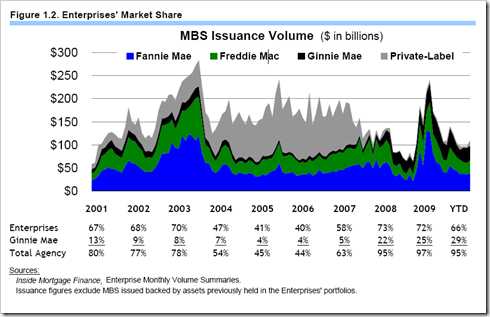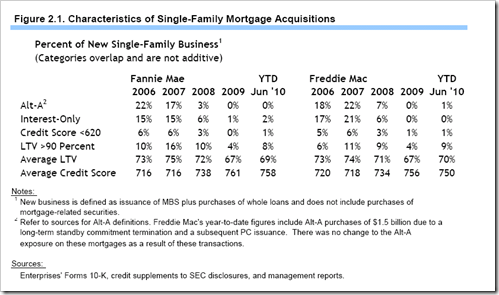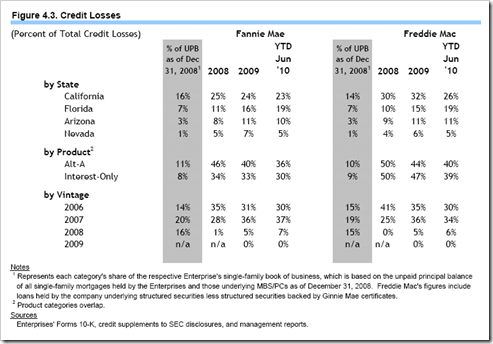Karl Smith is a Professor at UNC-CH and blogger at Modeled Behavior. He was a graduate fellow at the Institute for Emerging Issues, where his work was focused on state and local tax reform. Smith holds a BA and a PhD in economics from North Carolina State University.
~~~
The Conservator’s Report on Fannie and Freddie is out.
Fannie Mae and Freddie Mac are members of a long list of individuals and entities including Gary Condit, Tom Delay, Michael Jackson, Rod Blagojevich and JonBenet Ramsey’s parents. These are folks who were unjustly tried and convicted in the popular press essentially on the grounds that they were creepy or otherwise unsavory characters.
As I hope to continue to argue, being creepy, a bad person, or even a usual suspect does not make one automatically guilty of any particular crime. In this case government subsidies in the housing market are a bad idea for a host of reasons and have been for years. I will testify to this with vigor and passion.
However, that does not mean that Fannie or Freddie caused the housing bubble. Indeed, by my count they were among the biggest victims of it.
The proper question is not: What story is consistent with my general philosophy or worldview?
The proper questions is: What story is consistent with the facts?
>
Fact One: Fannie and Freddie’s primary business of subsidizing conventional loans was not a driver of the housing the bubble.
Indeed, conventional loans represented less than a third of all mortgage originations during the peak price acceleration years.
This was a phenomenon of private-label non-conventional loan securitization.
1.1 Peaking in 2006 at a third of all mortgages originated, the volume of Alt-A and subprime mortgages was extraordinarily high
between 2004 and 2007. In 2005 and 2006, conventional, conforming mortgages accounted for approximately one-third of all
mortgages originated[ . . .]
1.2 Private-label issuers played a large role in securitizing higher-risk mortgages from early 2004 to mid-2007 while the Enterprises
continued to guarantee primarily traditional mortgages.
>
Fact Two: Fannie and Freddie lost market volume during the boom.
That is, during the boom not only did the fraction of loans securitized by Fannie and Freddie fall, but the absolute number fell. At the same time the absolute number of private-label securitizations rose.
There is a simple and obvious reason for this. The development of structured products meant that for many consumers the free market offered a more attractive loan than the government subsidized one.
>
Fact Three: The major losses to Fannie and Freddie came through their expansion into guaranteeing non-traditional loans, not through their portfolio.
That is, yes like every other financial entity Fannie and Freddie were buying subprime packages in the secondary market. However, these losses were relatively mild.
The Investments and Capital Markets segment accounts for $21 billion, or 9 percent, of capital reduction from the end of 2007 through the second quarter of 2010. Losses in the Investments and Capital Markets segment stemmed from impairments of private-label securities, fair-value losses on securities, and fair-value losses on derivatives (used for hedging interest rate risk).
>
Fact Four:The key change in the Fannie / Freddie business model was their expansion in the types of loans they willing to guarantee. In particular moving into the Alt-A and Interest-Only categories.
As we can see these loans began to seriously underperform as the economy deteriorated. These loans were not a part of the original “crap hidden by structure” subprime business. Fannie / Freddie borrowers on had on average credit scores above 710 and equity (or down payment) of above 25%.
Also notice how loans with low credit scores and high loan-to-value had the largest delinquency rates in the beginning but then were eclipsed by Alt-A and Interest-Only loan categories as the economy deteriorated.
>
Fact Five: The higher number of Alt-A and Interest Only loans combined with ultimately higher delinquency rates have meant that a plurality of losses have come from these two categories.
These loans were vulnerable not because the borrowers were poor low-credit individuals that the government was taking pity upon but because the loan concepts were predicated on rising or at least stable housing prices.
>
Fact Six: Areas with the largest collapse in home prices have accounted for most of Fannie and Freddie losses.
Refer to the same graph above. This is further evidence that it was the collapse of the bubble and not betting on people who were poor credit risks that induced major losses at Fannie and Freddie.
My Conclusion
The wave of housing price increases was kicked off by changes in private label securitization. These changes left Fannie and Freddie with a smaller market share and lower absolute level of securitizations. Fannie and Freddie attempted to adjust their basic business practices to stay competitive in bubble markets and among aggressive borrowers.
These adjustment left Fannie and Freddie exposed to a large decline in housing prices. This is exactly what happened and Fannie and Freddie reaped enormous losses because of their exposure.
Had Fannie and Freddie stuck to their traditional role of guaranteeing low value traditional loans rather than trying to stay competitive in bubble areas their losses would have been substantially less.
In short, attempting to subsidize the American dream for low and moderate income families may be a fundamentally bad policy. However, it does not appear to be either the origin of the housing bubble or the source of Fannie and Freddie’s trouble.
~~~
Originally published at Modeled Behavior







What's been said:
Discussions found on the web: